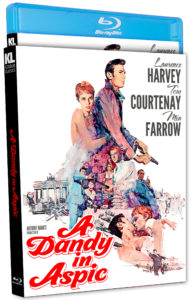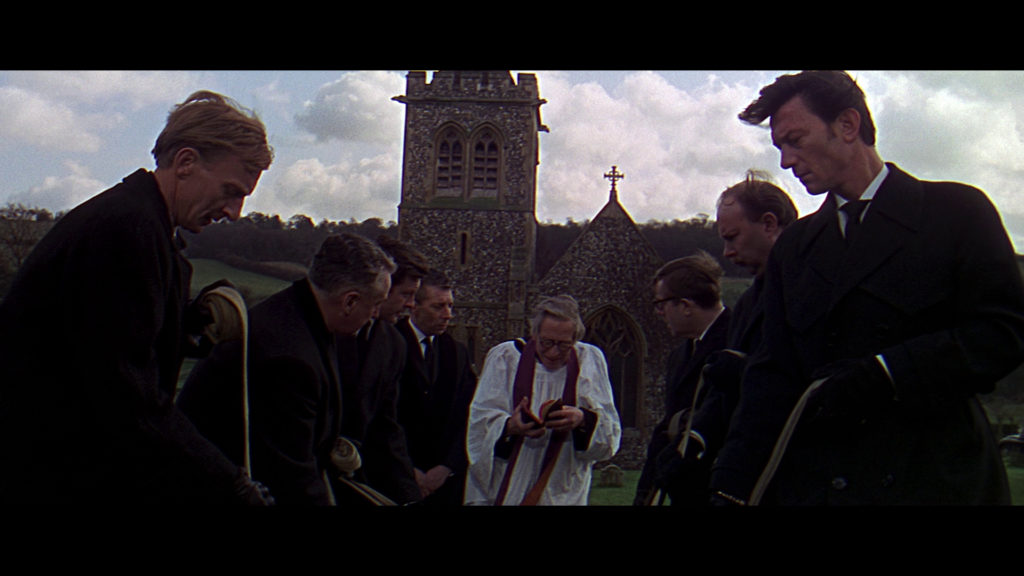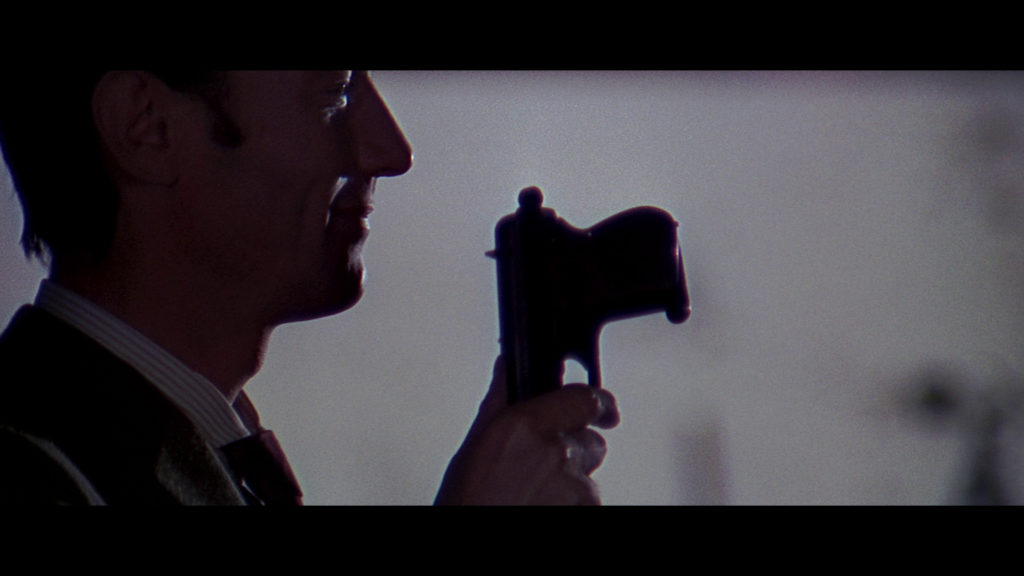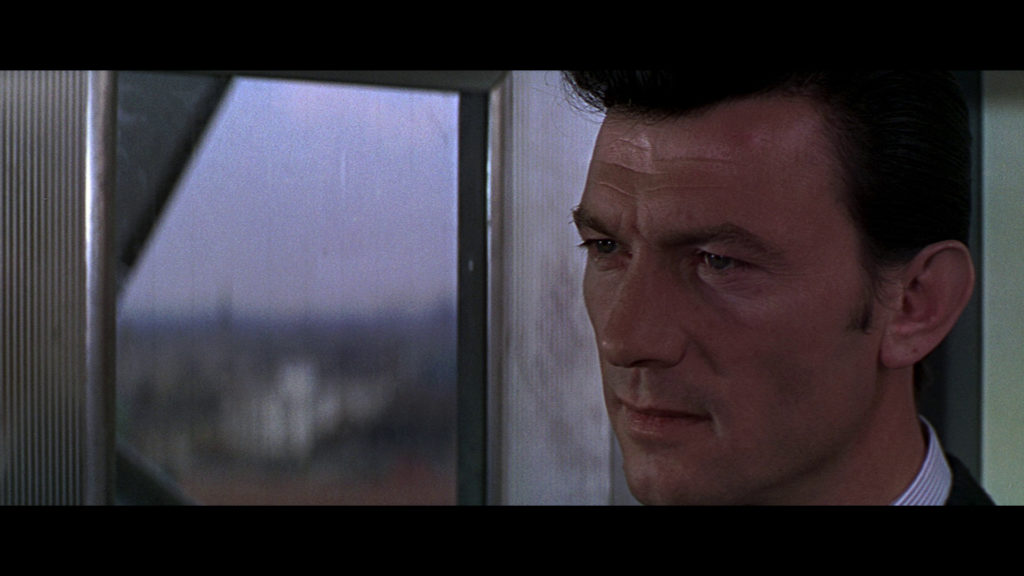Loyalty-Divided Spy And His Schizoid Misadventures In A Politically-Divided City
DIRECTED BY ANTHONY MANN (UNCREDITED: LAURENCE HARVEY)
STREET DATE: JULY 25TH, 2023/KINO LORBER STUDIO CLASSICS

Filmed at locations in London and West Berlin, Anthony Mann’s final film A Dandy in Aspic offers picturesque views of deceit, betrayal, treachery, and murder. Like many other decent Cold War-era spy-movies, and Dandy is often more than merely decent, the surface atmosphere of glamorous settings and stylish personalities is undercut, subverted, divided if you will by the moral complexities of the tense geopolitical situation that are their stories’ inescapable backdrop and thematic point of reference.
Who’s fooling who? While often it’s the story fooling the audience, author Derek Marlowe’s script, adapting his own 1966 debut novel, ingeniously presents a spy-protagonist who may ultimately be fooling himself. Serving both Russian and British masters as the story moves from sedate London to anxious West Berlin, the latter divided city reflects the divided loyalties of a character as confused by his nationality-torn predicament – symbolized in the film’s striking open credit-sequence as a puppet becomes entangled in its own strings – as we become in viewing it. Completed, uncredited, by star Laurence Harvey as the title Dandy, after director Mann unexpectedly died towards the end of production, a certain film-textual confusion in viewing may be either by design or necessity, but Kino Lorber Studio Classics’ new Blu-ray of this striking and strikingly-titled title less ambiguously presents a clear view on the murky international, spy-related shenanigans of fifty-five years ago.

Following the quaint London-suburb funeral of an associate fished out of a West Berlin ravine, British secret service office functionary Alexander Eberlin (Harvey) is recruited by higher-ups Brogue (Calvin Lockhart) and Fraser (Harry Andrews) from his clandestine organization to find and “retire” the Russian agent they believe responsible, known only as Krasnevin. The problem? Krasnevin is Eberlin, and as Krasnevin Eberlin owes his Russian superiors further intelligence on the inner workings and methods of British spies like himself. Past the mysterious disappearance of his friend Pavel (Per Oscarsson), whom the British may have mistaken for Krasnevin, Eberlin/Krasnevin is further tasked by both his British and Russian masters to confirm the unknown double-agent’s death in the divided city of Berlin.
Caught up between opposing forces which lay equal claim to his divided loyalties, Eberlin is assigned to neurotic, suspicious British control agent Gatiss (Tom Courtenay), while Krasnevin is attached to gregarious, wily Sobakevich (Lionel Stander), with only the effervescently aligned Caroline (Mia Farrow) offering anything approaching respite in the tension-filled atmosphere. Whether Eberlin or Krasnevin, Alexander is after all a dandy.

Both stylish and scenic throughout, perhaps the best compliment one can pay a film with a presumably turbulent production history is that one would be hard-pressed to say where its credited director’s contribution ends and where its uncredited star’s direction begins. From the early scene where Krasnevin attempts to flee to East Germany, and as Eberlin is blockade-forced back into West Germany, to a much-later moment in an abandoned arcade when Eberlin and Gatiss happen upon a sinister photo-booth, where a murdered British colleague spills corpse-out and credential-loaded with Krasnevin’s Russian identity, the division of opposing political and national affiliations in the wall-bordered city, and with a literal split-personality at its uneasy “center”, extends to the compositional disposition of the film-frame itself. With its frequent stylistic recourse to the split-diopter lens, no less, keeping each atmospherically-lit foreground plane precisely as “clear”, or not, the backdrop of shadowy figures lurking down dark alleys or rushing up dim side streets fill the frame admirably, and with appropriately dynamic complexity.
Returning to the question of identity, whether as friend to Pavel, lover to Caroline, employee and/or rival to Gatiss, rival and/or ally to Sobakevich, the many roles Alex assumes, including whether he takes his marching orders from Brogue or the (unseen) Rostopov, are ultimately irreconcilable, as is the film’s persistently off-kilter tone. Mixing dry comedy with harrowing consequences, Peter Cook in a small role as a British spy-functionary ogling a men’s magazine in an earlier scene, say, might have occasion to almost offhandedly deliver a devastating bit of information withheld from both the viewer and Alex by the film’s conclusion.

Like the cool, jazzy score contributed by Quincy Jones, A Dandy in Aspic reveals its deceptively effortless strength of carefully modulated atmosphere as balanced by the poise, or more accurately, pose, of its otherwise self-conflicted title-protagonist. It may be a cliche to say that a character is dressed to kill, but in Cold War-divided Berlin, with field agents mere pawns between world powers, possibly the best-looking and least affected among its twilight participants stand the best chance of survival.
Or perhaps not. In any event, with its surface sheen belying its more sinister undercurrents, the widescreen loveliness of its mid-century European settings opens an again deceptively pleasing view on canals, ravines, open-aired cafes, expansive racetracks, and curving boulevards. In viewing, then, this Dandy in his Aspic almost – emphasis, almost – makes one forget that there’s a barbed-wire covered concrete wall running down the middle of it all, and that that wall extends through the precise center of each inhabitants’ compromised heart.
Kino Lorber Studio Classics’ slick, slip-covered presentation of A Dandy in Aspic appropriately appears itself to conceal a re-issue of Australian label Imprint’s lapsed 2019-limited Blu-ray release of the film, with both the admirably clear-lined and colorfully-corrected transfer of the film imported along with its three accompanying short-documentary features. The first of the latter is a ten-minute collection of interviews from many of the film’s surviving production team, detailing the complexity and difficulty of the film’s production leading up to and immediately following the sudden death of director Anthony Mann on-location in West Berlin; the second are individual discussions by title designer Michael Graham Smith and puppeteer Ronnie Le Drew on Dandy‘s truly unique opening credits sequence, thematically visualizing a puppet being pulled by its strings in opposing directions simultaneously; and the third is a well-articulated analysis of Anthony Mann’s auteurist fingerprints on the film as a genre-piece, as finished without the genre-practitioner’s artistic input, by critic Richard Combs. Together, along with the superior image-quality presentation, now happily back in print, this reissue offers a near-comprehensive view of a neglected off-classic, which will hopefully receive more attention as the intriguingly compromised evocation of its Cold War-era it remains.
Images used in this review are credited to DVDBeaver and are used only as a visual reference to the film.

